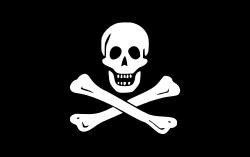Jolly Roger is the traditional English name for the flags flown to identify a pirate ship about to attack during the early 18th century (i.e. the later part of the "Golden Age of Piracy").
The flag most commonly identified as the Jolly Roger today, the skull and crossbones symbol on a black flag, was used during the 1710s by a number of pirate captains including Black Sam Bellamy, Edward England and John Taylor and it went on to become the most commonly used pirate flag during the 1720s.
Origins
Name
Use of the term Jolly Roger in reference to pirate flags goes back to at least Charles Johnson's A General History of the Pyrates, published in Britain in 1724.[1]
Johnson specifically cites two pirates as having named their flag "Jolly Roger": Bartholomew Roberts in June 1721[2] and Francis Spriggs in December 1723.[3] While Spriggs and Roberts used the same name for their flags, their flag designs were quite different, suggesting that already "Jolly Roger" was a generic term for black pirate flags rather than a name for any single specific design. Neither Spriggs' nor Roberts' Jolly Roger consisted of a skull and crossbones.[4]
Richard Hawkins, who was captured by pirates in 1724, reported that the pirates had a black flag bearing the figure of a skeleton stabbing a heart with a spear, which they named "Jolly Roger".[5]
The origin of the name is unclear. Jolly Roger had been a generic term for a jovial, carefree man since at least the 17th century and the existing term seems to have been applied to the skeleton or grinning skull in these flags by the early 18th century.[6] In 1703, a pirate named John Quelch was reported to have been flying the "Old Roger" off Brazil, "Old Roger" being a nickname for the devil.[7]
It is sometimes claimed that the term derives from "Jolie Rouge" ("Pretty Red") in reference to a red flag used by French privateers. This hypothesis is considered a false etymology, as the phrase "Jolie Rouge" in reference to a pirate flag does not appear in any historical sources.[8]
Another early reference to "Old Roger" is found in a news report in the Weekly Journal or British Gazetteer (London, Saturday, October 19, 1723; Issue LVII, page 2, col. 1):
Design
The first recorded uses of the skull-and-crossbones symbol on naval flags date to the 17th century. It possibly originated among the Barbary pirates of the period, which would connect the black colour of the Jolly Roger to the Muslim black flag. But an early reference to Muslim corsairs flying a skull symbol, in the context of a 1625 slave raid on Cornwall, explicitly refers to the symbol being shown on a green flag.[10] There are mentions of Francis Drake flying a black flag as early as 1585, but the historicity of this tradition has been called into question.[11] Contemporary accounts show Peter Easton using a plain black flag in 1612; a plain black flag was also used by Captain Martel's pirates in 1716,[12] Edward Teach aka Blackbeard, Charles Vane, and Richard Worley in 1718,[13] and Howell Davis in 1719.[14]
An early record of the skull-and-crossbones design being used on a (red) flag by pirates is found in a December 6, 1687 entry in a log book held by the Bibliothèque nationale de France. The entry describes pirates using the flag, not on a ship but on land.[citation needed][15]
17th and 18th century colonial governors usually required privateers to fly a specific version of the British flag, the 1606 Union Jack with a white crest in the middle, also distinguishing them from naval vessels.[16] Before this time, British privateers such as Sir Henry Morgan sailed under English colours.[5] An early use of a black flag with skull, crossbones, and hourglass is attributed to pirate captain Emanuel Wynn in 1700, according to a wide variety of secondary sources.[17] Reportedly, these secondary sources are based on the account of Captain John Cranby of HMS Poole and are verified at the London Public Record Office.
With the end of the War of the Spanish Succession in 1714, many privateers turned to piracy. They still used red and black flags, but now they decorated them with their own designs. Edward England, for example, flew three different flags: from his mainmast the black flag depicted above; from his foremast a red version of the same; and from his ensign staff the English national flag. Just as variations on the Jolly Roger design existed, red flags sometimes incorporated yellow stripes or images symbolic of death.[7] Colored pennants and ribbons could also be used alongside flags.
Marcus Rediker (1987) claims that most pirates active between 1716 and 1726 were part of one of two large interconnected groups sharing many similarities in organisation. He states that this accounts for the "comparatively rapid adoption of the piratical black flag among a group of men operating across thousands of miles of ocean", suggesting that the skull-and-crossbone design became standardized at about the same time as the term Jolly Roger was adopted as its name. By 1730, the diversity of symbols in prior use had been mostly replaced by the standard design.[18]
Historical designs
The gallery below showing pirate flags in use from 1693 (Thomas Tew's) to 1724 (Edward Low's) appears in multiple extant works on the history of piracy.[19] All the secondary sources cited in the gallery below are in agreement except as to the background color of Every's flag.




















No comments:
Post a Comment